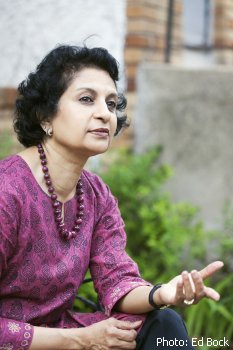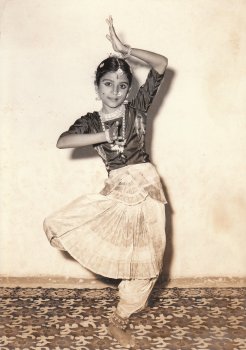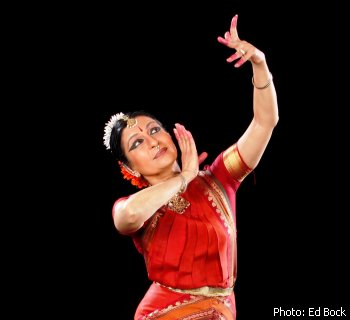
|
 |

|
 |
Ranee Ramaswamy: McKnight Distinguished Artist - Lalitha Venkat e-mail: lalvenkat@yahoo.com June 22, 2011  The Mcknight Distinguished Artist is an annual honor that includes a $50,000 cash award and recognizes individual Minnesota artists who have made significant contributions to the quality of the state's cultural life. On May 27, 2011 the McKnight Foundation of Minnesota named Minnesota-based dancer / choreographer Ranee Ramaswamy as the 2011 MCKNIGHT DISTINGUISHED ARTIST, in recognition of artistic excellence spanning more than three decades. Ranee Ramaswamy is the first dance artist to be selected as McKnight Distinguished Artist that is now in its 14th year. In 1992, Ranee established Ragamala Dance. In recognition of her choreography and performances, Ranee has received many grants and fellowships. Her work is supported by the National Endowment for the Arts, the Minnesota State Arts Board, The National Dance Project, and the Japan Foundation. Ranee is the principal dancer of Ragamala along with her daughters Aparna and Ashwini. Ranee has worked with celebrated artists of diverse backgrounds and disciplines, such as poet Robert Bly, jazz musician Howard Levy, jazz vocalist Charmin Michelle, Milwaukee-based African dance troupe Ko-Thi Dance Company, deaf actress Nicole Zapko, virtuoso music ensemble Speaking in Tongues, and five of the Twin Cities' most lauded dance makers-Danny Buraczeski (jazz), Joe Chvala (tap), Susana di Palma (flamenco), Wynn Fricke (modern), and Lise Houlton (ballet). Ranee's work has been commissioned by Zenon Dance Company, the University of Minnesota's Interplay Series, composer Jan Gilbert, and the Walker Art Center (Minneapolis). Ranee Ramaswamy shares her thoughts via e-mail. How does it feel to be recognised as the first dance artist for the MCKNIGHT DISTINGUISHED ARTIST? Since 1978,I have been teaching and performing Bharatanatyam in Minnesota where no one was familiar with it. In 1992 I started Ragmala Dance. 30 years later I feel honored that of all the various styles of dance and dancers that exist here in MN, they have picked an Indian dancer and this form. It shows not only the broad mindedness of Americans but also the greatness of our dance tradition that has impressed the panel and the community.  You did not exactly start dancing at an early age. What got you interested in dancing, Bharatanatyam in particular? Actually I started learning dance in Chennai at the age of 7. I danced until 17 and as traditional families do stopped, and after college got married and stayed home until I immigrated to the US in 1978 at the age of 26. The Indian community in MN asked me to perform for a Divali function in Nov of 1978; all I had was the love of dance, no music or costume. Someone gave me an alarippu tape by MLV and a Natanamadinaar tape by Kamala Lakshman. I bought a 25 dollar tape recorder and made up the dances, performed and found I loved to dance, and those who saw me liked what they saw and asked me to teach their children. I started to make trips to India to study with Chamundeeswari, disciple of Guru Dandayuthapani Pillai. I would go for 4 months a year, live with my parents and study around 10 dances that I could bring back and perform and teach. I regularly performed at all Indian festivals and started to teach my young daughter Aparna. In 1983, Alarmel Valli came to Minneapolis to conduct a residency that included classes and performances. I was on the board of the organization that brought her. I had never seen Valli perform before. When I saw her come on stage and start her performance, I was blown away! I had never in my life seen anything as powerful, moving, beautiful. My daughter Aparna who was 8 and I took classes with her and we have not stopped. Aparna Ramaswamy was her first student to do arangetram under Valli at the age of 12. We went to India every year and stayed in Chennai and studied with Valli for four months. I would write down every word that came out of our teacher's mouth. On our return, we would practice everyday and maintain all the points until our next trip. Meeting and learning from Alarmel Valli was a huge turning point and Bharatanatyam dance became the most important thing in my life. As a Bharatanatyam artiste, how have you been influenced by the diverse cultures in the US? As a citizen of the United States for over 33 years, I have maintained the authenticity of Bharatanatyam, but brought it in conversation with other diverse musical, visual, and cultural arts. Living in the United States, one is inspired by many different art forms. My interest is to find a common thread that would connect the two art forms to bring about an aesthetically pleasing and creatively challenging production. In Body and Soul, the songs of Billy Holiday, I performed with a jazz singer, Charmin Michelle and her seven piece jazz band, to interpret those songs that were very similar to Tamil padams. Of course the costume and the softness of rhythm had to be incorporated to suit the piece. I am proud to say all of Ragamala's dancers other than my two daughters, Aparna and Ashwini, are non-Indians. They have been dancing with Ragamala since its inception and given their entire lives to Indian dance. The net result is a company that is truly American but performs exquisite Indian dance.  You have collaborated with violinist Dr. L Subramaniam, the Çudamani ensemble from Bali and composers Shubhendra and Saskia Rao. What inspired you to make these collaborations / how did they come about? I will give you an example. I visited Bali in 1998 and was blown away by the Kecak, a performance by a hundred men which is a vocal tradition of chanting the cak or monkey chant while seated in a circle and moving the upper body constantly. The Balinese dancers perform Ramayana inside the circle. This was the inspiration around Sethu commissioned by the Walker Arts Center in Minneapolis in 2004. I wanted to work with a Balinese artist who would train the local Minnesotans to be the chorus around Ragamala dancers who perform the Ramayana for "Bhavayami Raguraman." I visited I. Deva Putu Berata from the Cudamani ensemble in Bali and invited him to Minneapolis with five cakkars. They trained forty American men for a month and the performance took place in the sculpture garden with an Indian orchestra, collaborating with a Javanese gammelon and thecak chorus. Deva played Hanuman, the monkey god. The five Indonesian performers performed as the Lakshman Rekha, the trees in Panchavati, the demons in Ravana's garden and the monkeys building the bridge. The musicians came walking across the bridge playing their instruments over the freeway to the sculpture garden, where a huge stage was erected and a large fire pit was lit. Sethu attracted 5000 audience members for over two nights. This way most of our collaborations use Bharatanatyam dance in unique settings and make conversation with other cultures while maintaining the integrity of our tradition. In "Transposed heads" by Thomas Mann, I danced with a Deaf actress and combined Bharatanatyam abhinaya with American sign language. She memorized the script while I could hear the narration and the music; we took cues from each other to make this a deep storytelling experience. I wrote and asked Dr. L. Subramaniam if he would create the score for Silappatikaram, a contemporary presentation combining Carnatic vocals from the Sangam era and continuous narration in English for a dance theatre piece. We got the American composer's grant to commission music. All the conversations happened over the phone, I sent him the narration and Prema's vocals; he created and recorded the score and emailed it to us! His music brought to life the characters of the story. The idea for the piece Yathra was conceived by Aparna Ramaswamy in conversation with Shubhendra Rao and the result was an evening length work for sitar and cello, bringing to the stage the cycle of one day compared with the lifetime of a human being. This piece was premiered at the Kennedy Center's Maximum India festival and had rave reviews. The entire piece had no lyrics, only instrumental music, even though the choreography incorporated poems from ancient Indian literature. In 1998 and 2004, you were named one of the "Artists of the Year" by the Star Tribune. Did you feel your responsibilities got higher because of that? The work is the most important for me and my daughter Aparna Ramaswamy, my co-artistic director (named by the Dance Magazine as one of the top ten to watch in the world in 2010), who has been dancing with me since she was 5 years old. There is always a sense to create stronger work, improve the quality of dancers, but such recognition gives me a satisfaction that it is noticed and rewarded. Do you feel there's a difference between how Indian classical dance was received years ago when you first started your dance school in the US and now? My intention was always to have a professional dance company and that is who we are. The school is only a small branch through which we spread this great art form. It has taken many years to have people understand and therefore enjoy performances of Indian dance. Also, the exquisite style of Pandanallur tradition as taught by Alarmel Valli to my daughter and myself has been shared with our dancers who perform incredibly well both physically and with emotional depth. All our company dancers are full time, training in classical Bharatanatyam. This has raised the standard of our dance, and thereby been noticed and appreciated by the audience and also presenters who are not only Indian but from the national dance community. Our production of 'Sacred Earth' premiering in September in Minneapolis is touring 22 cities, all in dance venues across the country. How easy/difficult has it been for you to get support through grants and fellowships for choreography and performance? I have been very fortunate to have received continued support both from local and national funding organizations in the United States for our work. I personally have received 13 McKnight fellowships in my career thus far. Ragamala is also funded by the NEA (National Endowment for the Arts), the NDP (National Dance Project), and International Funds for Travel from the Mid-Atlantic Arts Foundation, as well as corporations such as Target and General Mills. Ragamala receives support from the state of Minnesota for both production and touring. Also we have grown over the years with wonderful support from audiences and presenters. You toured India (Kerala) last year with your production. Can you share your experiences? It was an unforgettable performing experience for our dancers and the company as a whole. We performed Sthree in 8 cities in Kerala at the Soorya Dance festival. Sthree is a contemporary presentation of Silappathikaram for seven dancers with English narration running throughout. The musical score was by Dr. L Subramaniam and musical composition by Prema Ramamurthi of Hyderabad. The performances were very well received in all venues by press and audiences. This festival was well organized and the audiences very interested and knowledgeable. The audiences' response to English narration was very positive; many said they could understand and follow the story well. What is your vision for yourself, your school in the near future? Ragamala Dance is a performing company and not a school. Aparna and I do teach Bharatanatyam to a small group of people who are very interested and not as a large community school. Aparna's and my vision for the company is to continue to make work that is presented by both national and international dance venues. I would love to bring more of Ragamala's work to India. I have a legacy in my two daughters who will continue this work in the future. Both are full time dancers and are actively involved in running the company. I still dance with the company and look forward to continue to do so. We have interesting projects in the coming years which includes '1001 Buddhas' inspired by the Sanjusengendo Temple in Kyoto Japan and an untitled project with Rudesh Mahanthappa. We also look forward to more tours with Soorya, Kerala. Contact: raneeramaswamy@yahoo.com |